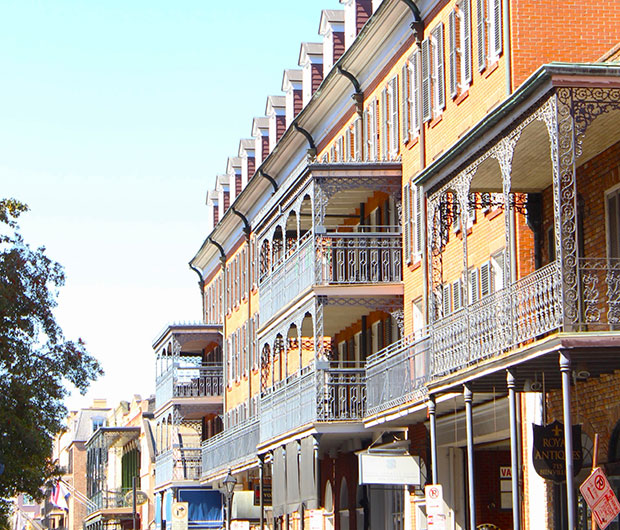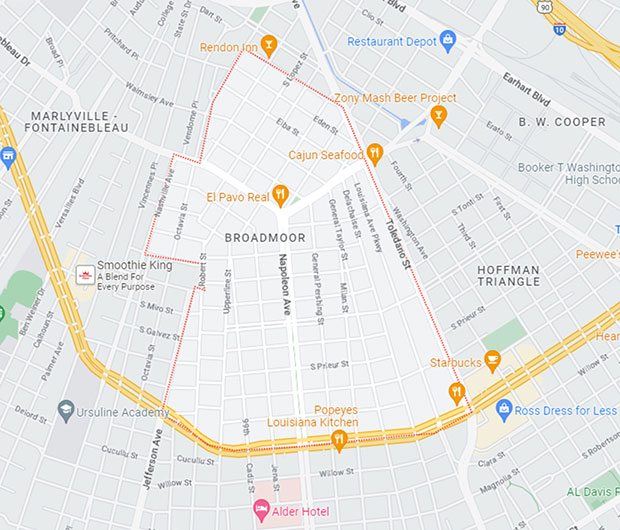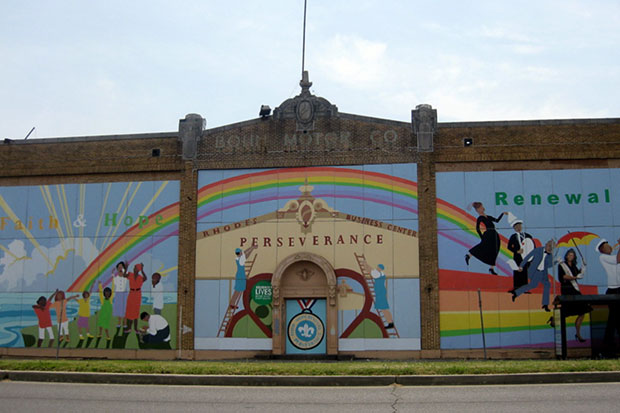Broadmoor Homes for Sale
Broadmoor has become a model for citizen-led recovery efforts, demonstrated after Hurricane Katrina devastated the low-lying area in 2005.
A newcomer by New Orleans standards, Broadmoor was made into the thriving residential neighborhood it is today through the addition of drainage canals and a pumping station at the turn of the 20th century. It sits at the crossroads between Mid-City and Uptown, making it a key connection between Uptown and Downtown via Napoleon Avenue. It’s also easily accessible from the rest of the city. Broadmoor includes the Broadmoor Historic District, which was listed on the National Register of Historic Places in 2003 and increased its boundaries in 2007.


Where Is Broadmoor?
Broadmoor is a sub-district of the Uptown/Carrollton Area. According to the U.S. Census Bureau, it has a total area of 358 acres.
Broadmoor’s boundaries, as defined by the City Planning Commission, are:
North: Eve Street
East: Washington Avenue and Toledano Street
West: Jefferson Avenue, South Rocheblave Street, Nashville Avenue, and Octavia Street.
Homes for Sale in Broadmoor, New Orleans
Why Buy a Home in Broadmoor?
Broadmoor occupies a lower-lying area of New Orleans and had flooded badly during Katrina. Yet, instead of becoming one of the designated city green spaces, Broadmoor came back strong thanks to the rebuilding efforts of its residents and the Broadmoor Improvement Association. Here are some other interesting facts and finds about this neighborhood.
Interesting 1930s and 1940s Architecture not typical of New Orleans: Craftsman-style houses and single-family cottages, many with generous, grassy yards and off-street parking (and even garages). One out of five houses has a raised basement.
Quaint and Quiet. Though not far from the French Quarter action, Broadmoor offers a quiet respite among its tree-lined residential streets.
Business Resurgence via the new commercial development near Washington and Broad Streets, including the relocation of Laurel Street Bakery and a new health clinic.
Rosa Keller Public Library and community center is considered the jewel of Broadmoor. It’s a popular community center and a busy public library, housed in a modernist building. Broadmoor is also home to Andrew Wilson Elementary School. Both structures flooded after Katrina and were designated to be demolished, but thanks to area activists were renovated instead. Today both are models of eco-friendly architecture, serving as a perfect embodiment of Broadmoor’s fighting spirit.
Notable Residents have included musician and producer Dave Bartholomew; writer and philanthropist Walter Isaacson; and local artist “Dr. Bob” Shaffer, best known for his “Be nice or leave” signs.
Broadmoor
Attractions
Broadmoor doesn’t have as many landmarks and tourist attractions as some other parts of the city, but this is still New Orleans, and so it has its share of notable eateries, most family-friendly. Explore some of our highlights below.
Grab a pastry or bagel at the homey Laurel Street Bakery or the tiny Gracious To Go on Earhart Boulevard. Gracious To Go is attached to the commissary kitchen of Gracious Bakery, now with three locations in New Orleans.
Have some excellent ramen for lunch at the relative newcomer’s Kin on Washington Avenue, a casual Asian joint with French flavors.


Get some crawfish to go at C & A Seafood on Jeff Davis Parkway. It also serves some basic Chinese food.
Watch the Saints game at the divey Rendon Inn in Gert Town. It has a pool table, outdoor seating, and serves grilled pub grub until 2 a.m.

History of Broadmoor, New Orleans
Truly situated in a below-sea-level bowl, Broadmoor includes areas of the lowest lying ground in New Orleans. It was a marshy swamp that connected to Bayou St. John and was a popular fishing spot, until the city developed a drainage system in the early 20th century. The first drainage canals were dug in the 1880s, and Pumping Station #1 at South Broad and Melpomene streets was completed in 1902.
Since then, Broadmoor has experienced a considerable population increase and a construction boom. Even the first houses built on what is now Broadmoor were raised, and it’s still a common sight in the area. Streetcar lines along South Claiborne Avenue and Napoleon Avenue linked Broadmoor to the city, and Broadmoor Civic Improvement Association was founded in 1930. In the late 1950s and the 1960s, however, the area had lost some of its residents to the burgeoning suburbs in Jefferson Parish and eastern New Orleans.
Broadmoor has been affected by several floods, including the Louisiana Flood in 1995, and again in 2005, by Hurricane Katrina. The latter brought in water as deep as 8 feet in some places. Because the area was hit so hard, one of the city’s proposed plans (presented in January 2006) was to turn the neighborhood into a “green dot.” The residents objected, rebuilding their own homes as soon as they could come back safely, and successfully campaigning on the federal and state levels to obtain funding to rebuild and add to the Andrew H. Wilson Elementary School and the Keller library and community center.
After Katrina and up to this day, Broadmoor has been experiencing a remarkable comeback, thanks to its residents’ resilient spirit and the notable efforts of the Broadmoor Neighborhood Improvement District.
